How the air conditioner works: the principle of operation of the air conditioner, its device and technical scheme
The key to long and effective operation of the air conditioner is its proper operation and regular maintenance. Do you agree? But in order to prevent breakdowns of this very expensive equipment, it is advisable to study the device, as well as consider the principle of operation of the air conditioner.
These are the issues we will discuss in our material - we will analyze in detail the main structural elements of typical climate equipment. And also let's talk about the principle and the features of its functioning, we give a typical diagram. We supplement the article with visual photos and useful video recommendations.
The content of the article:
Typical Air Conditioner
It is difficult to imagine the comfortable life of a modern person without air conditioning. And so that during its operation the user does not have problems and breakdowns, it is advisable in general terms to familiarize yourself with the device and the principle of operation of this type of climate equipment. We will talk about the main components and design elements of the air conditioner further.
The main structural elements of the equipment
If a user saw an air conditioner, which increases the comfort of his living, in the context, he would find a lot of structural elements and components. Some of them are used to control the unit, helps standard electronics and the user to control the situation.
And the main ones that affect functionality are structural elements such as:
- evaporator, which is located in the indoor unit of the air conditioner and is designed to ensure that the refrigerant used absorbs heat when converted to a gaseous state;
- capacitor - this structural element is located in the external unit of the air conditioner and is designed to ensure the transition of the existing refrigerant to a liquid state, with simultaneous heat generation.
At its core, both elements are radiators. Which occupy a significant part in the design of air conditioning units. This is necessary to ensure efficient heat transfer between the refrigerant and the air.
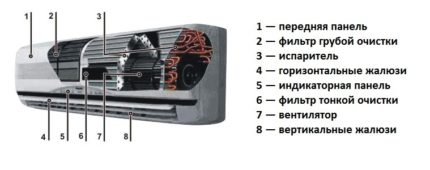
The evaporator and condenser are a structure consisting of small diameter copper pipes with transverse aluminum plates worn on them, which are designed to increase the heat transfer rate.
What else affects the performance of air conditioners?
In addition to the evaporator and condenser listed above, there are several more structural elements that ensure the efficiency of HVAC equipment.
These include:
- fans
- compressor;
- thermostatic valve (valve).
Products such as fansinstalled in each unit of the air conditioner. Their task is to enhance the air currents that blow the evaporator or condenser. Which significantly increases the performance of the system as a whole.
Compressor it is possible to call the heart of any modern air conditioner. The reason is that it is he who provides the movement of the refrigerant along the refrigeration circuit. Which usually consists of copper tubes.
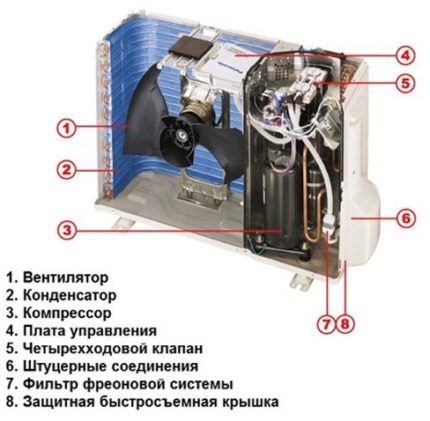
In addition, the compressor is designed to compress the refrigerant downstream of the evaporator. Which also improves the performance of any air conditioner.
We talked about compressor diagnostics and troubleshooting features in this stuff.
Thermostatic expansion valve Designed to reduce refrigerant pressure in front of the evaporator. This feature provides better heat transfer.
The role of refrigerant in the operation of HVAC equipment
Any modern air conditioning is a technical system consisting of a number of units and parts. But they will all be useless without refrigerant, which is a substance that easily passes from a liquid state to a gaseous state and vice versa. At the same time emitting or absorbing a significant amount of heat.
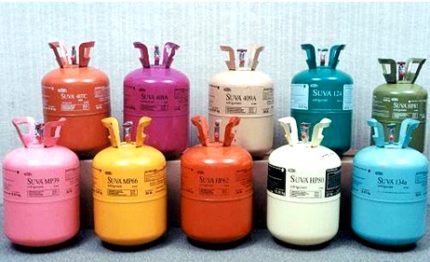
For many decades, various types of substances called freon have been used as refrigerants - this is mainly a mixture of ethane and methane. The main feature of this substance is its low boiling point. What happens at 5-10 ° C. In this case, freon during evaporation can be heated to 70-90 °. These features allow you to remove a huge amount of heat, and quickly enough.
And the specified refrigerant is colorless, odorless and, most importantly, harmless to the health of users. At the same time, the most popular type of freon today (R-22) has a negative effect on the ozone layer of the atmosphere. Therefore, if you are not indifferent to environmental problems, then you should purchase refrigerant air conditioners R-410. Which does not destroy the protective layers of the atmosphere.
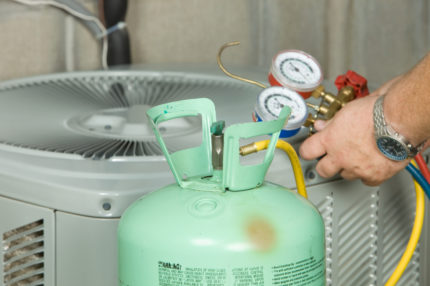
On practiceair conditioning freon rarely performed. For example, after repair, maintenance, leakage. And in any case, the specified refrigerant (R-410) does not harm the health of users and their pets.
The principle of operation and the scheme of the air conditioner
Air conditioning seems to be quite simple equipment, the main structural units of which are not particularly difficult. Therefore, we will analyze in detail its working principle, which is also extremely simple.
How does a typical air conditioner work?
Evaporating liquids absorb heat, moreover, actively, and during condensation (transition from a gaseous state back to liquid), it is released. And these physical phenomena are traditionally the basis of the principle of operation of air conditioners.
Make sure that this method of heat dissipation is effective, even at home. For example, by applying any alcohol-containing solution to the surface of your skin, which, quickly evaporating, leaves a feeling of cold. Since heat from the surface of the body is absorbed and removed to the side.
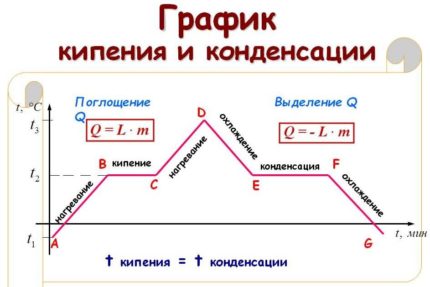
This is exactly what happens in the room. The reason is that liquid refrigerant, once in the indoor unit of the air conditioner, actively and in large quantities absorbs excess heat, while its temperature rises significantly.
As a result, it evaporates and moves to an external unit (usually located outside the building). Where, under the influence of colder air, in significant quantities pumped by the fan, the reverse process occurs.

That is, condensation is carried out, as a result of which the refrigerant again becomes liquid, while, accordingly, heat is released. And then a new cycle will follow, and so on to infinity.
Schematic diagram of the equipment
Regardless of the type, type and name of the air conditioner, the air cooling process is always the same. So after switching on the refrigerant is fed to the evaporator. At the same time, its pressure is 3-5 atmospheres, and the temperature is in the range of 10-20 ° C.
Further, in a gaseous state, freon moves into the compressor. And then it compresses to 15-20 atmospheres. In addition, the refrigerant is heated to 70-90 ° C.
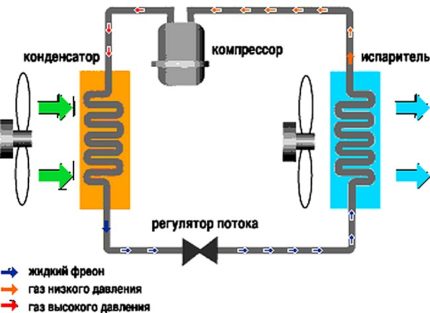
Then the gas is transported to the condenser, actively blown by the fan. As a result of exposure to injected air with a lower temperature, Freon generates heat, which leads to its transition into a liquid state.
But still, its temperature remains 10-20 ° C higher than the same indicator of ambient air. This problem is solved at the moment the fluid moves through the thermostatic valve. Where the refrigerant pressure is again reduced to small 3-5 atmospheres.This makes it possible for Freon to cool further and he is ready for a new heat absorption cycle, therefore he is again fed to the evaporator.
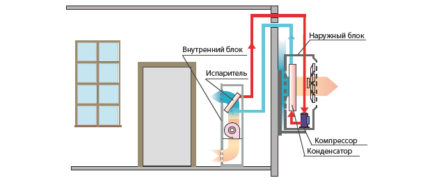
Features of the air conditioner
The air conditioner needs electric power to operate, but this is beneficial since it has a fairly high efficiency.
But if the network has regular voltage drops, then in order to avoid breakdown of this type of climatic equipment, you should immediately install and stabilizer.
Despite the simple and effective method of heat exchange, you should always remember that the air conditioner will meet the declared characteristics only with regular maintenance.
Conclusions and useful video on the topic
The video attached below will help to deepen and consolidate the knowledge gained on the topic:
The principle of operation of any air conditioner, regardless of brand, of typesimple enough. Since it is based on the simplest physical phenomena. At the same time, it should be remembered that climatic equipment has various technical characteristics. In addition, air conditioners are reliable, efficient, easy to operate. What you need to consider, like the future transition to safe freon, as this feature can lead to financial losses.
Do you want to supplement the above material with useful information or comments? Or do you have questions about the topic of our article? Ask them to our experts and other site visitors in the feedback section below.

 What is precision air conditioning: classification of devices and the principle of operation of units
What is precision air conditioning: classification of devices and the principle of operation of units 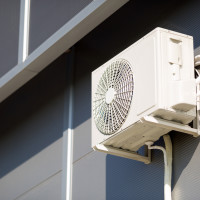 Common causes of air conditioning noise and how to resolve them yourself
Common causes of air conditioning noise and how to resolve them yourself 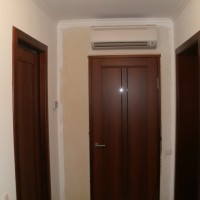 Installation of an air conditioner in the corridor: choosing the optimal location and the nuances of installing an air conditioner
Installation of an air conditioner in the corridor: choosing the optimal location and the nuances of installing an air conditioner 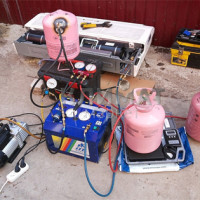 How to remove the air conditioner yourself without losing Freon: a detailed guide to dismantling the system
How to remove the air conditioner yourself without losing Freon: a detailed guide to dismantling the system 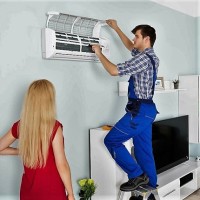 The necessary distance between the air conditioning units: basic rules and regulatory requirements for installation
The necessary distance between the air conditioning units: basic rules and regulatory requirements for installation 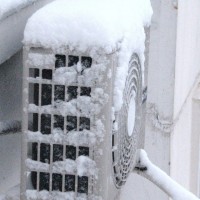 How to start air conditioning after winter: recommendations for caring for air conditioning after frost
How to start air conditioning after winter: recommendations for caring for air conditioning after frost  How much does it cost to connect gas to a private house: the price of organizing gas supply
How much does it cost to connect gas to a private house: the price of organizing gas supply  The best washing machines with dryer: model rating and customer tips
The best washing machines with dryer: model rating and customer tips  What is the color temperature of light and the nuances of choosing the temperature of the lamps to suit your needs
What is the color temperature of light and the nuances of choosing the temperature of the lamps to suit your needs  Replacement of a geyser in an apartment: replacement paperwork + basic norms and requirements
Replacement of a geyser in an apartment: replacement paperwork + basic norms and requirements